Solar Electrical Modules, Solar Panels, PV
Residential Grid-Tie Systems, Water Pumping, RV &
Marine, Remote Home Systems, Communication, Oil &
Gas, Traffic, Railroad, Lighting, Commercial
Grid-Tie Systems, Rural Development,
Government/Military, solar cell, grid-tie system,
solar system, solar panel, solar module, power
systems, photovoltaics, PV, sine wave, modified sine
wave, Energy Independence
Solar Modules Power
Characteristics:
The current and power output of photovoltaic
modules are approximately proportional to
sunlight intensity. At a given intensity, a
module's output current and operating
voltage are determined by the
characteristics of the load. If that load is
a battery, the battery's internal resistance
will dictate the module's operating voltage.
A module which is rated at 17 volts will put
out less than its rated power when used in a
battery system. This is because the working
voltage will be between 12 and 15 volts. As
wattage (power) is the product of volts
times amps, the module output will be
reduced. For example: a 50 watt module
working at 13.0 volts will produce 39.0
watts (13.0 volts x 3.0 amps = 39.0 watts).
This is important to remember when sizing a
PV system.
An I-V curve as illustrated to the right is
simply all of a module's possible operating
points, (voltage/current combinations) at a
given cell temperature and light intensity.
Increases in cell temperature increase
current slightly, but drastically decrease
voltage.
Maximum power is derived at the knee of the
curve. Check the amperage generated by the
solar array at your battery's present
operating voltage to better calculate the
actual power developed at your voltages and
temperatures.
Shading:
PV modules are very sensitive to shading.
Unlike a solar thermal panel which can
tolerate some shading, many brands of PV
modules cannot even be shaded by the branch
of a leafless tree.
Shading obstructions can be defined as soft
or hard sources. If a tree branch, roof
vent, chimney or other item is shading from
a distance, the shadow is diffuse or
dispersed. These soft sources significantly
reduce the amount of light reaching the
cell(s) of a module. Hard sources are
defined as those that stop light from
reaching the cell(s), such as a blanket,
tree branch, bird dropping, or the like,
sitting directly on top of the glass. If
even one full cell is hard shaded the
voltage of that module will drop to half of
its unshaded value in order to protect
itself. If enough cells are hard shaded, the
module will not convert any energy and will,
in fact, become a tiny drain of energy on
the entire system.
Partial-shading even one cell of a 36-cell
module, such as the KC120, will reduce its
power output. Because all cells are
connected in a series string, the weakest
cell will bring the others down to its
reduced power level. Therefore, whether ½ of
one cell is shaded, or ½ a row of cells is
shaded as shown above, the power decrease
will be the same and proportional to the
percentage of area shaded, in this case 50%.
When a full cell is shaded, it can act as a
consumer of energy produced by the remainder
of the cells, and trigger the module to
protect itself .The module will route the
power around that series string. If even one
full cell in a series string is shaded, as
seen on the right, it will likely cause the
module to reduce its power level to ½ of its
full available value. If a row of cells at
the bottom of a module is fully shaded the
power output may drop to zero. The best way
to avoid a drop in output power is to avoid
shading whenever possible.
Tilt Angle:
To capture the maximum amount of solar
radiation over a year, the solar array
should be tilted at an angle approximately
equal to a site's latitude, and facing
within 15º of due south. To optimize winter
performance, the solar array can be tilted
15º more than the latitude angle, and to
optimize summer performance, 15º less than
the latitude angle. At any given instant,
the array will output maximum available
power when pointed directly at the sun.
To compare the energy output of your array
to the optimum value, you will need to know
the site's latitude, and the actual tilt
angle of your array-which may be the slope
of your roof if your array is flush-mounted.
If your solar array tilt is within 15º of
the latitude angle, you can expect a
reduction of 5% or less in your system's
annual energy production. If your solar
array tilt is greater than 15º off the
latitude angle, the reduction in your
system's annual energy production may fall
by as much as 15% from its peak available
value. During winter months at higher
latitudes, the reduction will be greater.
Azimuth Angle and Magnetic Declination:
If a south-facing roof is unavailable, or
the total solar array is larger than the
area of a south-facing roof section, an east
or west-facing surface is the next best
option. Be aware that solar power output
decreases proportionally with a horizontal
angle, or "azimuth," greater than 15º from
due south. The decrease in annual power
output from a latitude-tilted east or
west-facing array may be as much as 15% or
more in the lower latitudes or as much as
25% or more in the higher latitudes of the
United States. Avoid directing your tilted
solar panels northwest, north or northeast,
as you'll get little power output.
Magnetic declination, the angle difference
between magnetic south and true solar south,
must also be taken into account when
determining proper solar array orientation.
If a magnetic compass alone is used to
determine where to point the array, you may
not capture the maximum amount of solar
radiation |


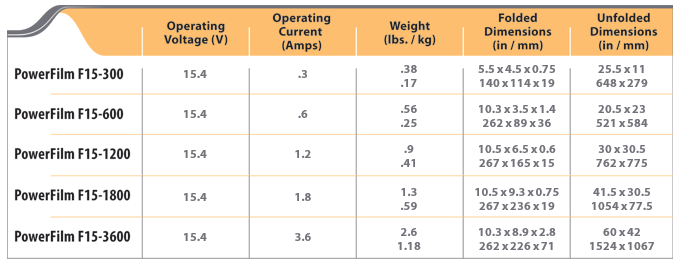

These accessories are professional
marine-grade components with connectors
that match the PowerFilm® Foldable and
Rollable Series output cord.
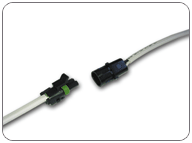


Ultra compact and ultra lightweight, the
PowerFilm® AA Foldable Solar Charger is
ideal for soldiers in the field. The
charger provides portable power for
charging AA rechargeable batteries. Once
unfolded, this charger automatically
begins charging. The charging lights
confirm if the batteries are charging or
fully charged. The specialized charging
circuitry provides highly effective
battery charging..
Applicationss
Recharge 2 or 4 AA rechargeable (NiMH or
NiCad) batteries to provide power for
any device that uses AA batteries..
Benefits::
• Provides lightweight on-soldier power..
• Reduces need for extra batteries..
• Supports rapid deployment and remote
locations with quick solar electric
power generation..
• Provides power for emergency needs..
• Tops off batteries to produce maximum
run time..
• Highly effective battery charging with
breakthrough charging circuitry..
Beatures::
• 2 Batteries : Full charge in about 4
hours of full sun..
• 4 Batteries : Full charge in about 8
hours of full sun..
• Integrates lightweight, rugged
PowerFilm® flexible solar panels
directly with fabric..
• Charging lights confirm if batteries
are charging or fully charged..
• Rugged construction with 6 grommets
for easy attachment..
• Charger adds less weight than carrying
4 extra batteries..
• 1 year warranty (see website for
details)..
• Patent applied for..
• CAUTION: Never charge Alkaline
batteries, they could leak and become
dangerouss
Information in PDF formatt
Military and Energencyy
Through various endeavors and
contracts with the military a group of
products were produced with the military
and strategic partners. These products
are made to fit the military’s needs and
specifications. Consumer versions of
some products are in production and
available for purchase through PowerFilm
or our strategic partners.

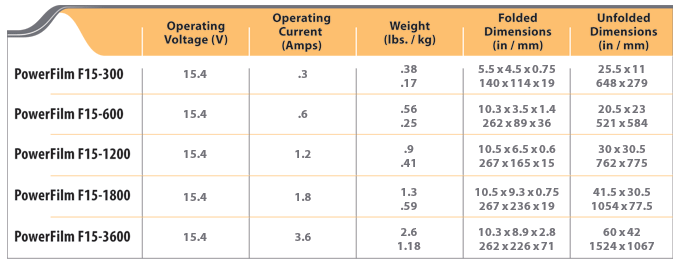
Rollable Solar Panels
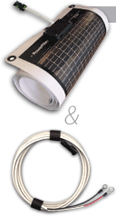 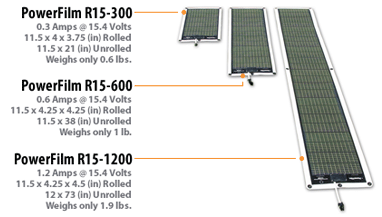
Power Film® integrated solar panels
(thin film on plastic) are developed and
manufactured with a proprietary roll
process by PowerFilm Incorporated, they
are truly rollable unlike other thin
film technologies that are only somewhat
flexible. PowerFilm® solar panels are
all monolithically integrated which
eliminates the damage-prone manual
connections of individual solar cells.
PowerFilm® is made of silicon, a natural
resource in abundant supply. PowerFilm®
is Cadmium Free, unlike some other solar
technologies, and performs well in
diverse environments, including hot sun,
and does not suffer from wasted
over-voltage..

PowerFilm® products are ultra rollable
because they are manufactured on a roll
up to 2400 feet long, using the
proprietary roll-to-roll manufacturing
technology platform of PowerFilm
Incorporated. PowerFilm Incorporated is
the first and only company in the world
to sell solar products manufactured on a
true roll-to-roll process using a
plastic substrate..
PowerFilm® products are monolithically
integrated which eliminates the
damage-prone manual connections of
individual solar cells. PowerFilm®
products are constructed using a durable
polymer (plastic) substrate..
Several features enable easy
integration: Paper thin low profile;
Ultra flexibility allows conformity to
shapes; Complete product design
eliminates need for unsightly bolt-on
frames..
Integrated with a fabric backing for
enhanced product functionality..
Constructed using a proprietary
combination of thin and lightweight
materials..
Cadmium Free! (Other solar technologies
such as CIS, CIGS, and CdTe contain
cadmium which is considered an extremely
toxic metal by the Department of Labor.)
If comparing products, check to be sure
they are Cadmium Free. Primary element
used in PowerFilm® is silicon, a natural
resource in abundant supply.
Solar Battery chargers foldable
Solar battery Charger
extremely rugged and
easy to carry and deploy
OkSolar military power requirements. The
overall benefits of our military solar
power products are to, enable extended
missions, improve logistics by enabling
field charging thereby reducing the
number of batteries in the field and
provide a significant cost reduction
when compared to primary batteries.
OkGlobal Solar Energy, Inc.
manufactures the highest performance
thin film solar cell products in the
world. Based on advanced NASA &
Department of Energy Technologies,
OkGlobal Solar products are lightweight,
portable, & rugged enabling new &
innovative commercial consumer,
military, & industrial applications. Our
vision is to bring solar to each and
every facet of life…to your home….to
you….to your national security.
military power requirements. The overall
benefits of our military solar power
products are to, enable extended
missions, improve logistics by enabling
field charging thereby reducing the
number of batteries in the field and
provide a significant cost reduction
when compared to primary batteries.
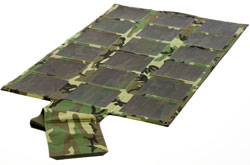 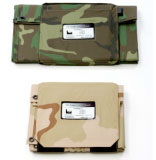 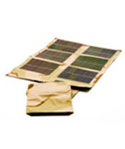 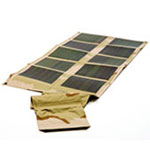

 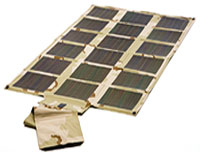
Included connection Kit
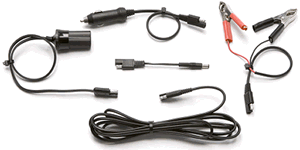 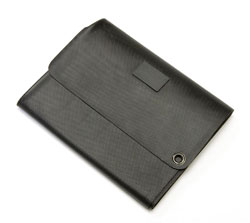 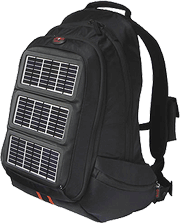
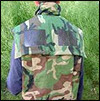
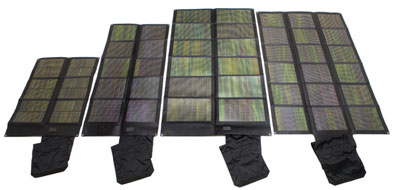
Ballistic Protection:
Stop this from
happening at once! Item#54780
-
Ballistic Protection - Bullet Proof Shields
-
This patented* shield incorporates leading edge
technology to provide maximum ballistics resistance.
-
The shield is primarily constructed of dual layer
polycarbonate sheets which are UV stabilized.
-
Designed to stop small arms fire .22 to .44 caliber
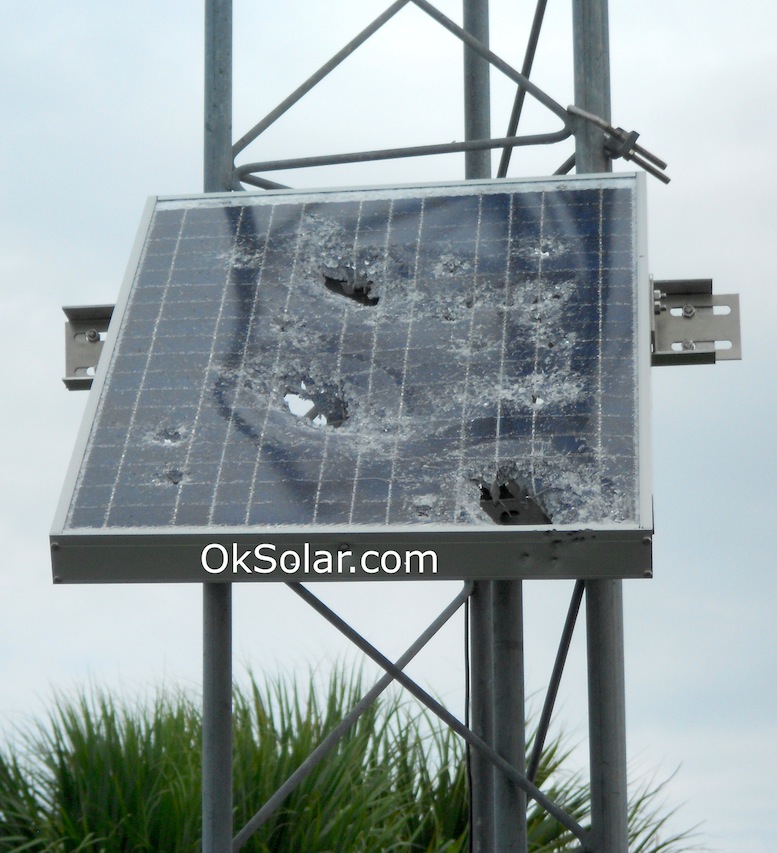 
Our Systems use State of the Art Plug and Play




V 7.07D
|